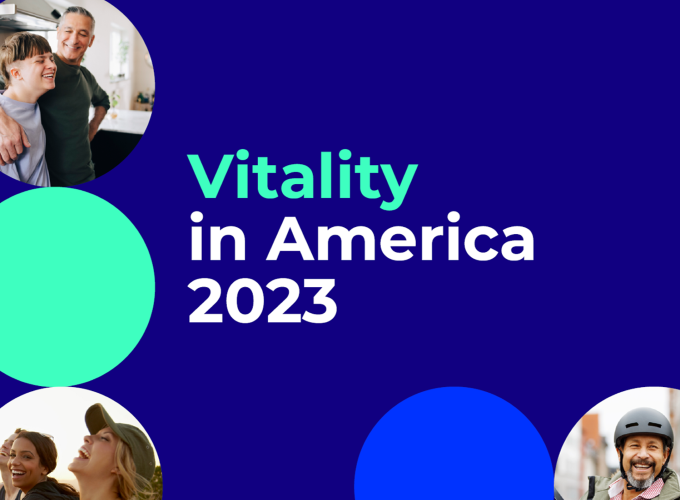
The U.S. health care system is on an unsustainable path. Today, the United States spends more on health care per person and as a share of gross domestic product (GDP) than any other country in the Organisation for Economic Co-operation and Development (OECD).
That was a key sentiment shared by The Cigna Group chairman and CEO David Cordani at an event hosted by the Boston College Chief Executives Club. “If you go back in time, every generation has afforded the next generation a longer, healthier life expectancy,” Cordani said. “My generation – current course and speed – will fail that. I start with that challenge every day staring in the mirror: How do we drive change and harness the innovative power that exists to improve overall quality of life?”
The state of health care today
The collective physical and mental health of Americans continues to be challenged. Today, 85% of health care spending is related to chronic diseases, and more than 1 in 5 U.S. adults live with a mental illness.
According to Cordani, the U.S. health care system has been built around treating those who are already sick – as opposed to doing something about the underlying causes of those problems in the first place. Addressing behaviors that contribute to poor or declining health could significantly reduce or eliminate many of the health challenges that our society faces today.
Research shows the majority of health care expenses and burdens are due to lifestyle and behavior factors – with diet, exercise, and smoking at the top of the list.
Cordani outlined four different health states across the U.S. population: acute, chronic, healthy, and healthy but at-risk. He estimates that at-risk individuals make up approximately 25% of the population. “If these risks go unmitigated, these people will reach a chronic or acute state in the next two years,” he said, adding that The Cigna Group is working to identify and understand this demographic in order to intervene early on and improve their quality of life.
Value-based care, Cordani said, holds tremendous potential for improving health while reducing unnecessary costs – and advancing a more sustainable health care system.
A vision for better health care – rooted in vitality and insights
At The Cigna Group, the work to reduce health challenges starts with vitality. The concept of vitality recognizes that health and well-being is increasingly multidimensional.
In its work to define the factors that make vitality as an important tool in reducing societal health challenges, The Cigna Group is partnering on extensive academic research in the U.S. and 12 other markets across the world. The research examines people’s vitality across generations and over time.
“The Vitality Index is a comprehensive measure to understand overall vitality – what every one of us wants for our loved ones – a vital, complete, highly engaged life,” Cordani said. “It measures physical health, mental health, spiritual health, financial health, et cetera. And what we have learned from it is that vitality in the United States has plateaued.”
The second annual Vitality in America study, released in November 2023, found that mental health and emotional well-being are the most significant drivers of vitality. In fact, adults with strong mental health are 10 times more likely to have high vitality than those with fair or poor mental health. The research also affirms the link between high vitality and workforce productivity, with high-vitality workers reporting they feel motivated to work hard to make their employer succeed, feel more enthusiastic about their job, and have higher job satisfaction.
That translates into higher levels of contribution for their employers, higher quality work, enhanced levels of engagement, better productivity, and more. And, Cordani noted, when businesses thrive, communities thrive.
Additionally, the research can hone in on specific geographies and demographics – providing insight into causation and enabling precision on potential solutions. Take residents of Boston, for example. Despite making more money on average, attaining a higher level of education, and having higher employment levels – all of which generally correlate to higher vitality – Bostonians are trailing the average American in overall vitality. They feel relatively less optimistic about their futures, more financially stressed, and less engaged in the workplace.
When looking at Gen Z adults in the U.S. – those born between 1997 and 2005, who are notable for their lower vitality levels – the research shows that this cohort continues to struggle with their mental health. Gen Z adults report lower personal confidence and self-esteem and express relative dissatisfaction with their personal and professional lives. Additionally, Gen Z adults in the workforce are more focused than their older counterparts on developing skills and gaining expertise, yet they feel underwhelmed by their workplace experiences. This may be due to the fact that Gen Z employees feel disconnected from their colleagues, and they lack the important managerial and social relationships that are essential for feeling alive and vital at work.
“We have found that connectivity is a powerful elixir for vitality,” Cordani said.
Why this matters
Employers of all sizes and across all sectors play a central role in helping employees overcome health challenges and in empowering them to live healthier and happier lives.
The vitality research points to several ways to achieve this. Employers must find meaningful ways to support employees in managing and regulating stress. Additionally, employers must provide opportunities and incentives for workers to feel the connectivity they are craving.
“We believe that if you can improve human performance, you can improve organizational performance, which improves a community’s performance and vitality,” Cordani said. “When you take a step back and look at the big picture it's a virtuous cycle. All three need one another. It requires partnership: public-private partnership, and academic and industry partnership.”

Vitality in America 2023
Take a closer look at this year’s Vitality in America study to learn how individuals can improve their health, well-being, and vitality.